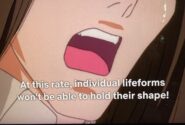My first club was immediately followed by a first rave. They weren’t the same, but for a while, they were inseparable. For some of us, one place was an excuse to get to the other. There were those who knew how to call it a night after that first dance. There were also those who never set foot in a club, before or after a rave. They refused to pay for dancing, for reasons tied to personal finances, a critique of partying as a commodity, or a kind of hedonism without schedules, external rules, or bouncers. Some of us were drawn to the shift in scale: how night was turning into day during the rave, with speakers, sneakers, and gestures coated in dust, dancing to BPMs hard to find inside a club. Not knowing when we’d make it home was part of our excess and undisciplined distraction.
(more…)Apnea #13 Conversation with Ran Zhang
We are all of us walking communities of bacteria.
The world shimmers, a pointillist landscape made of tiny living beings.
Lynn Margulis
Apnea #12 Conversación con Blanca Callén
And I am a material girl
Living in a material world
Madonna
As if we could scrape the color of the iris and still see
We mainly suppose the experiential quality to be an intrinsic quality of the physical object’-this is the so-called systematic illusion of color. Perhaps it is also that of love. But I am not willing to go there-not just yet. I believed in you.
Maggie Nelson
reassembling histories by putting them into bodies that dance
You pass a point where you’re beyond tired, beyond pain, beyond even thinking about stopping, thinking only that this could go on forever and you’d love it
Douglas Crimp
Apnea #10 Conversación con Tamara Díaz Bringas
Why am I compelled to write?… Because the world I create in the writing compensates for what the real world does not give me. By writing I put order in the world, give it a handle so I can grasp it. I write because life does not appease my appetites and anger…
Gloria E. Anzaldúa
APNEA #9 Conversación con Ania Nowak
The love expressed between women is particular and powerful, because we have had to love in order to live; love has been our survival.
Audre Lorde
APNEA #8 Conversación con Núria Gómez Gabriel
Under capitalism: You will be organized, you will be an organism. You will be a subject, nailed down as one
Deleuze & Guattari
APNEA #7 Conversación con Roc Jiménez de Cisneros
Los objetos no pueden ser reducidos a piezas de Lego a modo de átomos que pueden ser reutilizados en otras cosas. Tampoco pueden ser reducidos hacia arriba como instancias de un proceso global.
Tim Morton
Duchamp Already Dit It
“If irony was made of strawberries, we’d all be drinking a lot of smoothies right now”
Newscaster Ned
APNEA #6 Conversación con Iraida Lombardía
Travel becomes a strategy for accumulating photographs
Susan Sontag
Place, no emphasis. La dilatación del objeto.
The world is full of objects, more or less interesting; I do not wish to add any more.
Douglas Huebler
APNEA #5 Conversación con Xavier Acarin
“[Techno] wasn’t designed to be dance music, it was designed to be a futurist statement.”
Jeff Mills
APNEA #4 Conversación con Ian Waelder
Ultra Short Term Nostalgia: homesickness for the extremely recent past: “God, things seemed so much better in the world last week”
Douglas Coupland
APNEA #3 Conversación con Ángel Calvo Ulloa
Perhaps artworks are the only full-time curators I know.
Raimundas Malašauskas
Microfísica del dibujo
There is no way to make a drawing—there is only drawing.
Richard Serra
A Brief History of the Future
“Una historia del futuro puede ser el relato compartido de nuestras herramientas para el desconcierto”
APNEA #2 Conversación con Ania Nowak
We need to borrow the energy from the future to overturn the conditions of the present
Rosi Braidotti
APNEA #1 Conversación con Serafín Álvarez
Leer era nuestro videojuego.
AGGTELEK, Travel Notes.
Me gusta el fútbol porque puedo odiar sin sentimientos de culpa… entre otras cosas
Todo cuanto sé con mayor certeza sobre la moral y las obligaciones de los hombres, se lo debo al fútbol.
Albert Camus
En busca del futuro perdido: especulaciones subjetivas desde la ciencia-ficción
For me, the only true science is science fiction
Jacques Lacan
Catoptrophilia: la aleación de la imagen.
“La necesidad de la máscara y la incapacidad de soportar su peso”
Parergon: el suplemento como experiencia
“My teacher says I’m slow, my Mama thinks I’m special”
De Kassel yo recuerdo Berlín
Cuanto más de vanguardia es un autor, menos puede permitirse caer bajo ese calificativo.
Enrique Vila-Matas
Esperar durante: el imperativo como trayecto.
The work of art assumes the existence of the perfect spectator, and is indifferent to the fact that no such person exists.
E. M. Foster
Adyton: gramáticas de la audiencia
De la narrativa arquitectónica al espacio como relato y la experiencia artística polimorfa.
Read the text: the conversation is not given
El diálogo como otro marco de existencia para el arte
Lo íntimo ya no intimida. (De)composition de Jesús Monteagudo Guerra
Un fantasma recorre el arte, el fantasma de la intimidad.
Estrategias de disociación: Esto no es una exposición de arte, tampoco
De la desmaterialización de la obra al materialismo del concepto
Expeditions to the void: incursiones artísticas en el discurso científico
Art for science sake
Què fer a Sabadell: de evento cultural en evento cultural y tiro porque me toca
Cuando la cultura consume al espectador
Art/fònic: inserciones artísticas en circuitos mediáticos
Cuando el arte sale del espacio expositivo y lo visible se hace audible
Deseo de testigo o la narración como montaje, de Iván Gómez.
Todo testimonio es un montaje
15 piezas en 3 actos: se abre el telón
Teatro y arte contemporáneo: simbiosis por yuxtaposición

#01
Mireia c. Saladrigues
Relfexiones en torno a la obra de la artista, el rol del espectador y su capacidad de emancipación de las reglas del juego artístico
La cuestión del paradigma: digresiones sobre el arte emergente en Barcelona
Del arte emergente y otros demonios.
El lloc dels fets: escenas de un crimen en la Sala d’Art Jove
De cómo freir un filete de lomo al revés, toparse con una familia de jabalíes en la Budellera, esconder el Santo Grial en la copa de la Champions o pasear por una Barcelona Mordorizada….
Yo no estuve aquí. Un proyecto de Aníbal Parada
De lo que no se puede hablar, ¿es mejor callar?
Berlin über alles
Incursiones diletantes en otras coyunturas artísticas durante la indulgencia del periplo vacacional.
Radicalmente emancipado(s) de Mireia c. Saladrigues
¿Qué ocurriría con el arte si todos los espectadores se emancipasen?















































